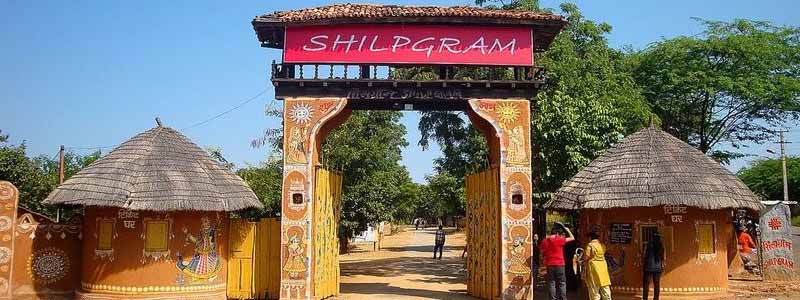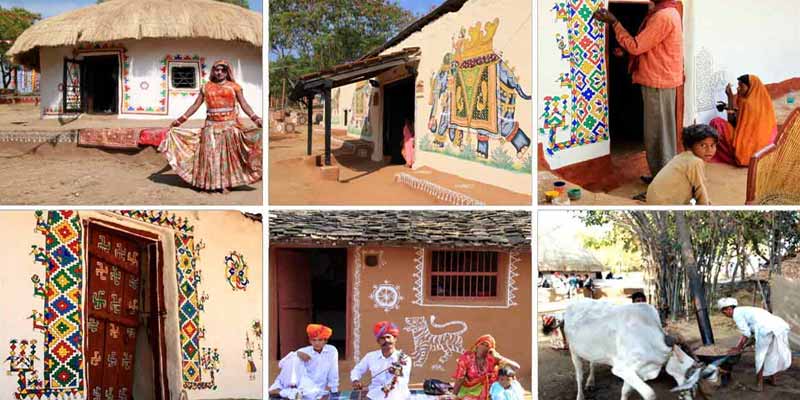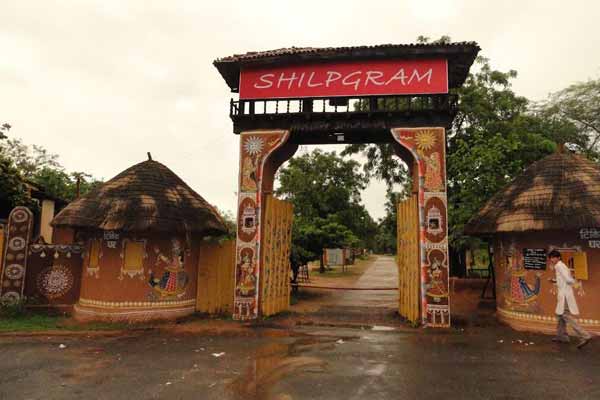Shilpgram Museum Udaipur, literally Craftsmen’s Village, is situated 3 kms from Udaipur, near Hawala village. The village itself is a living ethnographic museum setup to showcase the diverse craft, art & culture from various Indian states. There are twenty-six huts set in 70 acres of natural surroundings at the foot of the Aravali Hills and each has a different state as its theme. The lifestyles of the folk and tribal people of the West Zone can also be studied at this village at close quarters. The artists and craftsmen also come here to learn through camps and seminars as well as to display their skills and interact with people.
The Shilpgram Mela or Fair is organised during annually for ten days during November – December. An amphitheatre with a seating capacity of 8,000 brings alive the performing arts of the region. Udaipur Tour Packages Theatre festivals and traditional performing arts all find an enthusiastic audience here.
This place is an excellent opportunity to purchase the handicrafts directly from artisans.

History of Shilpgram
The Shilpgram is an ideal place to interact and explore the artistic fervor of the Indian culture. It is a place where history, culture, and heritage are bound together to offer a ravishing image of glorious Indian past. Rajiv Gandhi inaugurated Shilpgram Museum Udaipur in the year 1989.
The place is situated in the old countryside of Udaipur Monuments to give an unbiased portrayal of rural life of artisans. The Shilpgram festival conducted on the last ten days around the year end, is an age-old tradition. The artisans and performers flock here from all over to country to showcase their talent and high spirits.

Architecture of Shilpgram
Surrounded by several huts, Shilpgram Museum Udaipur is constructed in the old architectural style to offer the feel of rural markets. The small huts are built using mud and natural building material to give the real picture of the ethnic diversity of the western states of India. The hut offers workspace to occupational dwellers making the place a lot livelier.
Every hut or traditional village house has a distinct style and features reflecting the history and culture of each state it is representing. The occupational homes of the artisans are constructed in an adjoining manner to reflect the concept of “Unity in Diversity.” There are about 26 huts which include five from Rajasthan, five from Maharashtra, five from Goa and seven from Gujarat.
There is an open-air amphitheater in the Shilpgram Museum Udaipur Complex offering a seating facility for about 8000 people. The amphitheater is used to conduct festivals at regular intervals. The special tribal and folk dances performed during the celebrations are a treat to watch.
Attractions of Shilpgram Museum:
It was set up by the West Zone Cultural Centre, Udaipur. It is a living ethnographic Museum which depicts the life style, traditions, customs and folk arts of the rural and tribal people of the five West Zone States of India (Rajasthan, Goa, Gujarat, Maharashtra, Daman and Diu) and showcases the diversity in art, craft and culture between various Indian States.
It comprises of 26 huts set in 70 acres of natural surroundings at the foot of the Aravalli Hills. These huts have been constructed in the traditional architectural style using mud and local building material to reflect the geographical and ethnic diversity of the different States of West zone of India. There are 5 huts representing the State of Rajasthan, 7 huts representing the State of Gujarat, 5 Huts representing the State of Goa, 5 huts representing the State of Maharashtra and 2 huts representing Daman and Diu.
The rural artisans and folk artists reside here and perform in the natural surroundings in a village environment. The major attraction here is the exquisite terracotta work in dark red and dark brown sand material along with the wooden carvings and simple objects of everyday use. The Museum invites the urban ceramists, potters, designers and visual artists to work with their rural counterparts for creating works of everyday art, which are then put up for exhibition and also for sale to visitors. So this place provides an excellent opportunity to purchase the handicrafts directly from the artisans.
A fair named ‘Shilpgram Utsav’ is organised here by the West Zone Cultural Centre, Udaipur every year from 23rd December to 1st January, during which the open air Amphitheatre with a seating capacity of about 8,000 brings alive the performing arts of the region. It is a National annual art and craft fair organised in rural surroundings amidst the ethnic atmosphere of Shilpgram, which attracts thousands of visitors both from within the Country and abroad.
Best Time to visit Shilpgram
The Shilpgram is at its best in the month of December. In the last ten days of the year, the annual fair is conducted. The lively nature of the festival offers both educational benefits and entertainment. The Shilpgram takes place every year for the duration of 10 days from 21st December to 30th December.
How to reach Shilpgram
Located about 10 km away from Lal Ghat, Shilpgram is situated at an easily accessible location. You can take a flight, train or a bus to reach Shilpgram.
Airport- The Maharana Pratap Airport is located 23.3 Km away from Shilpgram. Once you are out of the airport, you can take a private cab or use taxi service to reach your location.
Train- The Udaipur railway station is located 2.4 Km away from Shilpgram. You can take a cab or an auto-rickshaw from the station to reach Shilpgram.
Public Transport- There is plenty of deluxe and non-deluxe buses available to and from Udaipur. The State-run buses are the best option as they are both safe and comfortable.
